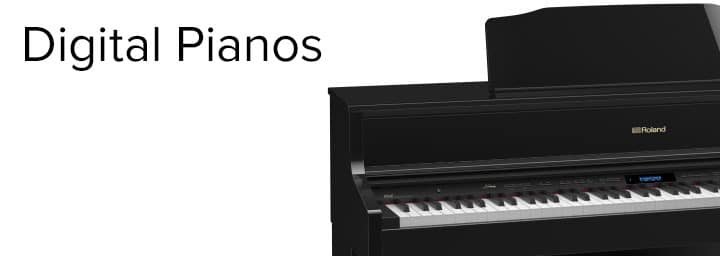Here’s something you may not realise about great digital pianos…
Digital pianos are great, but truly great digital pianos are rare. This is because getting it just right is difficult. Most digital pianos use their technology to produce their sound, key touch, and sound systems. We also fully respect the authentic process of acoustic piano sounding. Everything from key touch, the piano frame itself and the resonance of other strings, and meticulously reproduce this process by our unique digital technology. Here are three reasons why a Roland digital is a better piano.
Contributed by Roland Europe Team
Sounding this SIMPLE is quite COMPLICATED
 An acoustic piano is beautifully simple yet profoundly complex; a wonderful collision of physical materials which produces a rich piano tone. But although a piano sounds simple and pure it’s anything but shallow, with an enormous dynamic range spanning fragile, delicate highs to crashing, thunderous lows, each note underpinned by detail and depth. It’s little surprise that conventional digital pianos struggle to measure up. Which is a problem: the piano is a player’s instrument and when it doesn’t sound right, you can really feel it (or not, as the case may be.)
An acoustic piano is beautifully simple yet profoundly complex; a wonderful collision of physical materials which produces a rich piano tone. But although a piano sounds simple and pure it’s anything but shallow, with an enormous dynamic range spanning fragile, delicate highs to crashing, thunderous lows, each note underpinned by detail and depth. It’s little surprise that conventional digital pianos struggle to measure up. Which is a problem: the piano is a player’s instrument and when it doesn’t sound right, you can really feel it (or not, as the case may be.)
So rather than try to make yesterday’s piano a little bit better, we decided on a different direction. Instead of merely recording the sound of each note, why not recreate it, along with the physical interactions that give a piano its unique signature tone? It took decades to develop the technology, and you’re probably not interested in how it works. But you’ll definitely be interested in how it sounds, and how it feels to play.
We call it SuperNATURAL Piano and we think it’s the most exciting thing to happen to the piano since the piano. Play one and you’ll hear where we’re coming from. You’ll notice a far greater dynamic range, comprising brighter highs and darker lows, infused with colour, character and long natural decays that fade to nothingness. You’ll hear more detailed harmonics when playing fortissimo passages, and fast key repetition no longer forces you to compromise your style while the piano tries to keep up. And as you play, you’ll forget that you’re playing a digital piano. Which is exactly how it should be. Playing a digital piano can be as inspiring as an acoustic – when it’s a SuperNATURAL Piano.
Why TOUCH comes before FEELING
 If you watch a great pianist at work, you’ll appreciate their phenomenal hand-eye co-ordination. Sports psychologists call it ‘flow’; where mind and body are in complete sync and the player isn’t even thinking about what they’re doing. Obviously, getting into the flow is hard, but getting back out is simple. All it takes is a minor irritation and you come crashing back down to Earth.
If you watch a great pianist at work, you’ll appreciate their phenomenal hand-eye co-ordination. Sports psychologists call it ‘flow’; where mind and body are in complete sync and the player isn’t even thinking about what they’re doing. Obviously, getting into the flow is hard, but getting back out is simple. All it takes is a minor irritation and you come crashing back down to Earth.
Now, we’re not all virtuoso musicians, but you’ll be surprised at how well developed your own internal senses are – that sense of what feels right to the musician and what doesn’t. And with great pianos, the sound is just one half of the equation: the other is feel. When a piano is built to a price, the quality of the keyboard action is the first thing to go; crazy when you think about it, as it’s the only part of the piano that you ever touch.
With a sound engine as powerful as SuperNATURAL Piano, we needed an equally responsive keyboard to get the most out of it. Conventional keyboards weren’t accurate enough, so we had to develop a keyboard that could translate emotion into sound. Our latest PHA-4 keyboard is the result. Designed so you barely notice it’s there, the responsiveness of the PHA-4 keyboards is matched only by the detail and power of the SuperNATURAL engine.
Great Digital Pianos – SOUND that you can FEEL, as well as HEAR
Acoustic and digital pianos produce sound in different ways. With an acoustic, it’s all about physical reactions – hammers hit strings, which reverberate through the cabinet to produce the sound. Digital pianos often use a simple set of speakers, which can struggle to project a convincing sound.
Some of our great digital pianos pianos include an Acoustic Projection system, comprising four or even six speakers that are discretely placed to project the piano’s various sound elements from their natural positions. These elements are then blended in the air space surrounding you, reproducing the sound field of an acoustic piano with stunning accuracy. It’s rather difficult for a digital piano to sound this realistic. But we’ve cracked it.
Subscribe below and receive everything you need to know about starting to play the piano.





